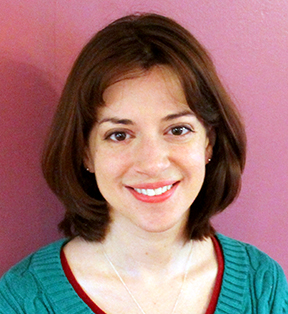Lindsay R. Triplett

Department of Plant Pathology and Ecology
Jenkins-Waggoner Laboratory, Room 113
The Connecticut Agricultural Experiment Station
New Haven, CT 06511
Cell: 574-709-8701 Lab: 203-974-8611
Personal Research Website: http://writetolindsaytrip.wix.com/triplett
Expertise
Dr. Triplett serves as Vice Director, and Chief Scientist for the Department of Plant Pathology and Ecology. She is a plant microbiologist and molecular geneticist. She
studies the DNA sequences of plant-infecting bacteria to answer questions about
their virulence mechanisms and phylogenetic diversity, and to develop diagnostic
tools for disease detection.
Research Interests
In the past, her research has characterized the molecular interactions
between Xanthomonas oryzae and rice, focusing on resistance to a
few secreted proteins that act as toxins or transcriptional activators. She is
now continuing that line of research on other plant pathogenic Xanthomonas species that infect a variety of
crops.
Education
B.A. (2004); Earlham College, Biology
Ph.D. (2009); Michigan State University, Plant Pathology
Appointments
2022-present Vice Director, The CAES
2022-present Chief Scientist and Department Head, Plant Pathology and Ecology, The CAES
2019-2022 Associate Agricultural Scientist, The CAES
2014-2019 Assistant Agricultural Scientist, The Connecticut Agricultural Experiment Station (CAES)
2011-2013 USDA-NIFA Postdoctoral Fellow, Colorado State University
2010-2014 Postdoctoral Scientist, Colorado State University
2006-2009 Graduate Research Assistant, Michigan State University
2004-2006 Plant Science Fellow, Michigan State University
Selected publications from the author, Lindsay.Triplett@ct.gov
(* indicates shared lead authorship)
T. Shidore, C. D. Broeckling, J. S.
Kirkwood, J. J. Long, J. Miao, B. Zhao, J. E. Leach, and L. R. Triplett. (2017). PLOS Pathogens, 13: e1006442.
T. Shidore and L.R. Triplett. (2017). Toxin-antitoxin systems: Implications
for plant disease. Annual Review of
Phytopathology, 55, DOI:
10.1146/annurev-phyto-80516-035559.
Leach, J. E., L. R. Triplett, C. T. Argueso, and P. Trivedi. (2017). Communication in the phytobiome. Cell, 169, 587-596.
Langlois, P. A., J. Snelling, J. P. Hamilton, C. Bragard, R. Koebnik, V. Verdier, L. R. Triplett, J. Blom, N. A. Tisserat, and J. E. Leach. (2017). Characterization of the Xanthomonas translucens complex using draft genomes, comparative genomics, phylogenetic analysis, and diagnostic LAMP assays. Phytopathology, 107, 519-527.
Read, A. C., F. C. Rinaldi, M. Hutin, Y.-Q. He, L. R. Triplett, and A. J. Bogdanove. (2016). Suppression of Xo1-mediated disease resistance in rice by a truncated, non-DNA-binding TAL effector of Xanthomonas oryzae. Front. Plant Sci., DOI: 10.3389/fpls.2016.01516.
Triplett, L. R., T. Shidore, J. Long, J. Miao, S. Wu, Q. Han, C. Zhou, H. Ishihara, J. Li, B. Zhao, and J. E. Leach. (2016). AvrRxo1 is a bifunctional type III secreted effector and toxin-antitoxin system component with homologs in diverse environmental contexts. PLOS ONE, 11, e0158856
Triplett, L. R., S. P. Cohen, C. Heffelfinger, C. L. Schmidt, C. Tekete, V. Verdier, A. J. Bogdanove, and J. E. Leach. (2016). A resistance locus in the American heirloom rice variety Carolina Gold Select is triggered by diverse TAL effectors and is effective against African strains of Xanthomonas oryzae pv. oryzicola. Plant Journal, 87, 472-48
Han, Q., C. Zhou, S. Wu, Yi Liu, L. R. Triplett, J. Miao, J. Tokuhisa, L. Deblais, H. Robinson, J. E. Leach, J. Li, and B. Zhao. (2015). Crystal structure of Xanthomonas AvrRxo1-ORF1, a type III effector with a polynucleotide kinase domain, and its interactor AvrRxo1-ORF2. Structure, 23, 1900-09.
Triplett, L. R., V. Verdier, T. Campillo, C. Van Malderghem, I. Cleenwerk, M. Maes, L. Deblais, R. Corral, O. Koita, B. Cottyn, and J. Leach. (2015). Characterization of a novel clade of Xanthomonas isolated from rice leaves in Mali and proposal of Xanthomonas maliensis sp. nov. Antonie van Leeuwenhoek 107, 869-881
Wonni, I., B. Cottyn, L. Detemmerman, S. Dao, L. Ouedraogo, S. Sarra, C. Tekete, S. Poussier, R. Corral, L. Triplett, O. Koita, R. Koebnik, J. Leach, B. Szurek, M. Maes, and V. Verdier. (2014). Analysis of Xanthomonas oryzae pv. oryzicola population in Mali and Burkina Faso reveals a high level of genetic and pathogenic diversity. Phytopathol., 104, 520-531.
P. A. Fory, L. Triplett,C. Ballen, J. F. Abello, J. Duitama, M. G. Aricapa, G. A. Prado, F. Correa, J. Hamilton, J. E. Leach, J. Tohme, and G. M. Mosquera. (2014). Comparative analysis of two emerging rice seed bacterial pathogens. Phytopathol.,104, 436-444.
Verdier, V.*, L. R. Triplett*, A. W. Hummel, R. Corral, R. Andres Cernadas, C. L. Schmidt, A. J. Bogdanove, and J. E. Leach. (2012). TAL effectors targeting OsSWEET genes enhance virulence on diverse rice varieties when expressed individually in a TAL effector-deficient strain of Xanthomonas oryzae. New Phytol., 196, 1197-1207. (*shared lead authorship)
Triplett, L., J. Hamilton, C. R. Buell, N. A. Tisserat, V. Verdier, F. Zink, and J. E. Leach. (2011). Genomic analysis of Xanthomonas oryzae from rice grown in the US reveals substantial divergence from known X. oryzae pathovars. Appl. Env. Microbiol., 77, 3930-3937.
Triplett, L., W. Wedemeyer, and G. W. Sundin. (2010). Homology-based modeling of the Erwinia amylovora type III secretion chaperone DspF used to identify amino acids required for virulence and interaction with the effector DspE. Res. in Microbiol., 161, 613-618.
Triplett, L., M. Melotto, and G. W. Sundin. (2009). Functional analysis of the N-terminus of the Erwinia amylovora secreted effector DspA/E reveals features required for secretion, translocation, and binding to the chaperone DspB/F. Mol. Plant-Microbe Interact., 22, 1282-1292.
Synergistic Activities
Professional Service. Associate Editor of the journals Phytopathology (2015- ) and Phytobiomes (2016- ). Session co-organizer and moderator at the Annual Meetings of the American Phytopathological Society (APS, 2013 and 2014) and the Congress of the International Society of Molecular Plant-Microbe Interactions (2016).
Advising and
Mentoring. Currently
mentors two postdoctoral researchers (one co-mentored with Jan Leach), one
undergraduate student, and one medical student researcher. Previously served as
advisor to one Masters' student and directed the student projects of six
undergraduate researchers and two rotation students.
Teaching and outreach. Guest course lecturer at Mitchell College, Quinnipiac University, and Southern Connecticut State University (2015-16). Display organizer at CAES Plant Science Day public outreach event (2015- ). Invited speaker at Yale Green Café outreach event (2015).

